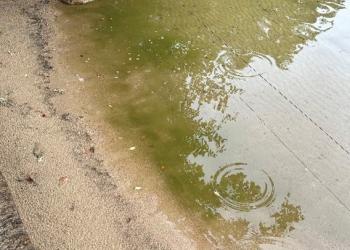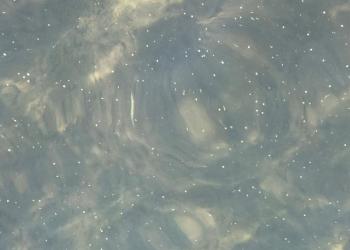Cyanobacteria
Contact
Cyanobacteria Sightings Reported - Gloeotrichia
CONCORD, NH – Many sightings of the unique cyanobacteria called Gloeotrichia have recently been reported for Lake Winnipesaukee, primarily in the Wolfeboro and Alton areas. Lake Wentworth has also had reports. This is common to see during the late summer! The colonies look like very small, fuzzy balls in the water. Each colony of Gloeotrichia may contain approximately 5,000 cells. They can appear either green or sometimes brownish-yellow by eye.
Oftentimes, these cyanobacteria stay suspended in the water and do not accumulate to large concentrations. Under certain conditions, however they can accumulate along shorelines in more dense concentrations of material, occasionally forming green or yellow clouds or surface scums. Oftentimes these accumulations do not last long and become mixed back into the water to lower densities. These blooms can rapidly change and accumulate in various locations around a waterbody. Please monitor your individual shorelines for changing conditions and avoid contact with areas with dense accumulations, please also keep pets out. If the density looks low, the risk of recreating in that water should be low. Some folks compare it to a night sky - if it looks like a starry night, the risk is low, but if it looks like a galaxy consider staying out of the water and keeping pets out.
Please check the Healthy Swimming Mapper for all current cyanobacteria listings, including areas that have had reported Gloeotrichia. If you need to report a particularly dense bloom, please do so through our Bloom Report Form. You can also sign up to get email updates (alert or warning issuance and removal) through our Cyanobacteria Email List. For Winnipesaukee, please specify “Winnipesaukee” for the waterbody, and the town(s) you are interested in. Any additional details on location on Winnipesaukee can be added to the water body line, for example “Winnipesaukee – Jockey Cove”.
New Hampshire researchers are studying Gloeotrichia cyanobacteria. To learn more, please visit the following:
Dartmouth College Gloeotrichia Project
Lake Sunapee Protective Association
UNH Center for Freshwater Biology
Cyanobacteria are natural components of water bodies worldwide, though blooms and surface scums may form when excess nutrients are available to the water. Some cyanobacteria produce toxins that are stored within the cells and released upon cell death. Toxins can cause both acute and chronic health effects that range in severity. Acute health effects include irritation of skin and mucous membranes, tingling, numbness, nausea, vomiting, seizures and diarrhea. Chronic effects may include liver and central nervous system damage. Be cautious of lake water that has a surface scum, changes colors, appears cloudy or has green streaks or blue-green flecks.
For more information, see the NHDES Harmful Algal Bloom Webpage and our Frequently Asked Questions. You can also sign up for Weekly Statewide Cyanobacteria Updates.
Left Image: Example of a high density of Gloeotrichia, stay out of the water and keep pets out.
Right Image: Example of low density of Gloeotrichia, risk should be low.






